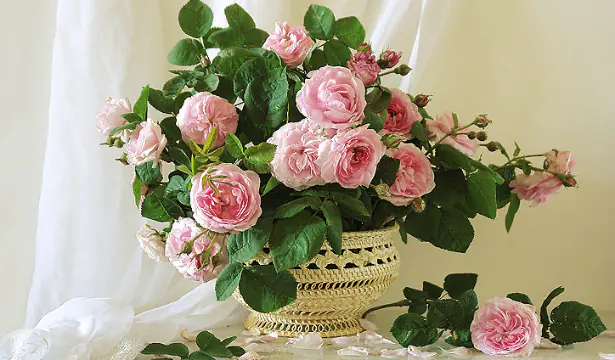The rose has always been considered the queen of flowers, for its incomparable beauty, multi-layered petals and divine aroma.
It was first grown in ancient Rome, where the rose was known as a symbol of femininity, art and wealth. At famous Roman feasts, the entire floor was covered with rose petals, the columns and walls of the hall were decorated with pink garlands, wine goblets were entwined with flowers and the feasters were showered with pink petals. It seemed that the whole world was fragrant and filled with beauty and perfection. Alas, sometimes this crossed all boundaries. There is a known case when at a Roman feast, guests simply suffocated in the sweet aroma, as they did not have enough fresh air.
Main beneficial properties
Rose is a medicinal plant rich in minerals. Preparations with essential oils and rose extracts can stimulate and harmonize the body’s immune and nervous systems, improve the functioning of the endocrine glands, and restore skin cells or internal organs. Rose infusions normalize the functioning of the digestive tract and heal the mucous membranes of organs. And inhaling the aroma of the flower can relieve an attack of weakness, headache or dizziness. For mild nervous disorders and stress, rose aromatherapy sessions are recommended. To carry it out, a bowl of boiling water is placed in the room and several rose flowers are placed in it. Inhaling the rose aroma is relaxing, calming and calming.
Rules for collection and drying
The best time to collect rose petals is at dawn or in the early morning hours, when the air is clean and filled with moisture. Rose, unlike other medicinal plants, is best collected after rain and with dew drops. Petals are plucked by hand from flowers that are open, fresh and full, not wilting.
After collection, they are laid out on thick paper, sorted and dried in a shady, well-ventilated place. The petals can be dried until completely dry to be used in winter for making teas, infusions or decoctions, or you can make rose jam from fresh raw materials.
Application
Fresh rose petals have high bactericidal activity, so they are used to treat various skin diseases. For example, for acne or psoriasis, fresh petals are applied to the affected areas for a while. Such compresses can be used to heal purulent wounds, for sunburn, and also to relieve itching due to allergies.
A bath of rose petals can relieve fatigue, anxiety, support heart function and cleanse the skin. Not only tea rose petals are suitable for a bath, but also faded rose petals from a bouquet given to you. Half a glass of petals is poured with boiling water and left for a couple of hours in a sealed container so that the valuable essential oil does not evaporate.
It is recommended to drink rose tea as a medicine for colds, pharyngitis, bronchitis, neuroses and an excited state of the nervous system. To brew tea you need 1 teaspoon of dry petals and a glass of boiling water.
Rose petal jam is tasty and healthy. It cleanses the body of toxins, can heal wounds in the oral cavity and relieve inflammation of the gums. And yet, it is worth remembering, no matter how tasty pink jam is, you should not abuse it. After all, in everything you need to know when to stop.



